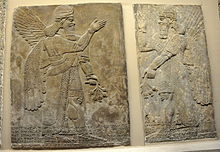The Apkallu (Akkadian), or Abgal (Sumerian), are seven Mesopotamian (Sumerian, Akkadian, Assyrian, Babylonian) sages, demigods who are said to have been created by the god Enki (Akkadian: Ea) to establish culture and give civilization to mankind. They were noted for having been saved during the flood. They served as priests of Enki and as advisors or sages to the earliest kings of Sumer before the flood. They are credited with giving mankind the Me(moral code), the crafts, and the arts. They were seen as fish-like men who emerged from the sweet water Abzu. They are commonly represented as having the lower torso of a fish, or dressed as a fish.
Contents
[hide]The myth[edit]
According to the myth, human beings were initially unaware of the benefits of culture and civilization. The god Enki sent from Dilmun,[1] amphibious half-fish, half-human creatures, who emerged from the oceans to live with the early human beings and teach them the arts and other aspects of civilization such as writing, law, temple and city building and agriculture.[2] These creatures are known as the Apkallu.
The Apkallu remained with human beings after teaching them the ways of civilization, and served as advisors to the kings.[3]
Historical references[edit]
The Apkallus are referred to in several Sumerian myths in cuneiform literature. They are first referred to in the Erra Epic[4] by the character of Marduk who asks "Where are the Seven Sages of the Apsu, the pure puradu fish, who just as their lord Ea, have been endowed with sublime wisdom?"[5] According to the Temple Hymn of Ku'ara, all seven sages are said to have originally belonged to the city of Eridu. However, the names and order of appearance of these seven sages are varied in different sources. They are also referred to in the incantation series Bit Meseri's third tablet.[6] In non-cuneiform sources, they find references in the writings of Berossus, the 3rd century BC, Babylonian priest of Bel Marduk. Berossus describes the appearance from the Persian Gulf of the first of these sages Oannes and describes him as a monster with two heads, the body of a fish and human feet. He then relates that more of these monsters followed. The seven sages are also referred to in an exorcistic text where they are described as bearing the likeness of carps.[7]
Order of appearance[edit]
Though the order of the appearance of the sages is not precisely agreed upon, Conrad and Newing give an order of their appearance:
The first is Uanna, "who finished the plans for heaven and earth",
The second is Uannedugga "who was endowed with comprehensive intelligence",
Third came Enmedugga "who was allotted a good fate",
Next was Enmegalamma "who was born in a house",
Fifth was Enmebulugga "who grew up on pasture land",
The sixth is An-Enlilda "the conjurer of the city of Eridu",
and last came Utuabzu "who ascended to heaven."
Conrad and Newing identify Utuabzu as the legendary Assyro-Babylonian mythical figure, Adapa,[8] while others identify Uanna with Adapa.[9]
Ante and post-diluvian presence[edit]
These seven were each advisers for seven different kings and therefore result in two different lists, one of kings and one of Apkallu. Neither the sages nor the kings in these lists were genealogically related however.[10] Apkallu and human beings were presumably capable of conjugal relationships since after the flood, the myth states that four Apkallu appeared. These were part human and part Apkallu, and included Nungalpirriggaldim, Pirriggalnungal, Pirriggalabsu, and Lu-nana who was only two-thirds Apkallu. These Apkallus are said to have committed various transgressions which angered the gods. These seeming negative deeds of the later Apkallu and their roles as wise councillors has led some scholars to equate them with the nephilim of Genesis 6:4.[8] After these four post-diluvian Apkallus came the first completely human advisers, who were called ummanu. Gilgamesh, the mythical king of Uruk, is said to be the first king to have had an entirely human adviser.[3] In recent times, scholars have also suggested the Apkallu are the model for Enoch, the ancestor of Noah.[11]
Apkallu reliefs appear prominently in Assyrian palaces as guardians against evil spirits, particularly during the Neo-Assyrian Empire (911-605 BC). They are one of the more prominent supernatural creatures that appear in the art of Ashurnasirpal II of the 9th century BC. They appear in one of three forms, bird-headed, human-headed or dressed in fish-skin cloaks.[12]



No comments:
Post a Comment